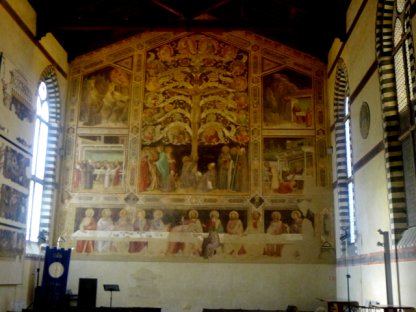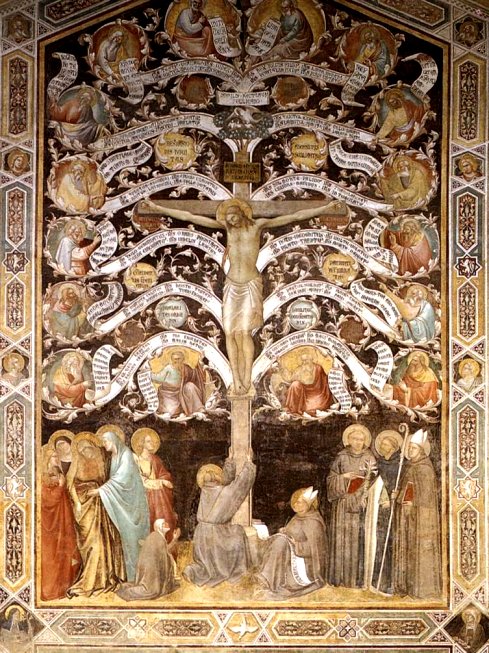|
The
Legend of the True Cross, 3. |
| It would be a great mistake to think of the Franciscans of Arezzo and Florence as naive believers in fairy tales. Both sequences I've looked at are representations of quite complex Franciscan theology. One way to get to grips with this is the leave Santa Croce through the side door and visit the refectory, now a museum containing some magnificent art. Perhaps the most poignant item is the badly damaged crucifix by Cimabue, a victim of the floods in Florence in 1966. On a wall of the refectory is this fresco by Taddeo Gaddi, Agnolo's father. Very few visitors have a clue what it represents; I certainly didn't when I was there. My recent research on this topic has helped a little! |
|
|
|
The lower section is the most familiar - the Last Supper. The four panels
that surround the main image take a little more sorting out. Top left and
bottom right are familiar too; St Francis receives the stigmata, and Mary
Magdalene washes the feet of Christ. As with the Magdalene image, the
other panels match the Last Supper theme by depicting events at meals,
but rather obscure ones; 'The Priest
at his Easter Meal Receiving Word of St Benedict's Hunger in the
Wilderness' (top right) and 'St Louis of Toulouse Feeding the Poor and
Sick of Toulouse'. It's the centre panel we are interested in, and here it is. |
|
|
| Saint Bonaventure (1221 –
1274) was probably the greatest Franciscan theologian. In The Tree of
Life he meditates on the life and death of Christ. He uses
the allegory of a tree and its fruits to represent a range of virtues.
The idea starts in Genesis: 'And out of the ground made the LORD God to grow every tree that is pleasant to the sight, and good for food; the tree of life also in the midst of the garden, and the tree of knowledge of good and evil.' (Ch 2 v 9) And is expanded in Revelation chapter 22: ' And he shewed me a pure river of water of life, clear as crystal, proceeding out of the throne of God and of the Lamb. In the midst of the street of it, and on either side of the river, was there the tree of life, which bare twelve manner of fruits, and yielded her fruit every month: and the leaves of the tree were for the healing of the nations.' (v1 - 2) Gaddi's fresco is becoming a little clearer. Each branch has the opening text of one of the twelve sections of Bonaventure's book; various prophets holding scrolls of prophecies take the place of fruit. For Bonaventure, the key 'virtues' of the fruit of the tree are redemption and salvation. In his words: 'This is the fruit that took its origin from the Virgin's womb and and reached its savoury maturity on the tree of the cross under the midday heat of the Eternal Sun, that that is, the love of Christ . . . . This most beautiful 'flower of the root of Jesse' (Isaiah 11.1) which has blossomed in the incarnation and withered in the passion, thus blossomed again in the resurrection so as to become the beauty of all' (From The Tree of Life, quoted by Christopher Irvine in The Cross and Creation in Christian Liturgy and Art. ) How does this relate to the two fresco sequences? Christ the Redeemer is seen as the new Adam, and the Virgin as the new Eve. What was lost and buried in the earliest images chronologically, has burst into bloom. The offspring of the Tree of Life from Paradise provides the wood of the cross that offers the prospect of eternal life in Paradise; a second creation. Even Adam himself is redeemed when Christ descends to Hell, as prophesied by the Archangel at the start of the narrative. In the words, this time, of St Paul: 'For as in Adam all die, even so in Christ shall all be made alive.' How does St Francis fit into this? For Bonaventure, the stigmatic Francis is a new Christ. The final scene of the cycle shows the return of the Cross to Jerusalem, celebrated as the Feast of the Exaltation of the Holy Cross, an important feast day held on September 14th. September 14th is also, traditionally, the date on which Francis received the stigmata. If you read commentaries on the Piero and Agnolo frescos you will notice that some suggest that the tree involved in the story is the tree that grew that all-too-tempting apple, the Tree of Knowledge. They are quite wrong. As I've tried to show here, the Tree of Life is central to Franciscan theology, and, of course, both churches were Franciscan. My thoughts, after working on this theme? I'm entirely unqualified to comment on the theology, but as a writer, I am in awe at the understanding and exercise of the power of allegory and image demonstrated by Piero della Francesca, the Gaddis, those Franciscans, and above all St Bonaventure. I'm writing this in the middle of December, and now every home is setting up its Christmas tree. Pagan symbol or not, I'm sure Bonaventure would be delighted. |

